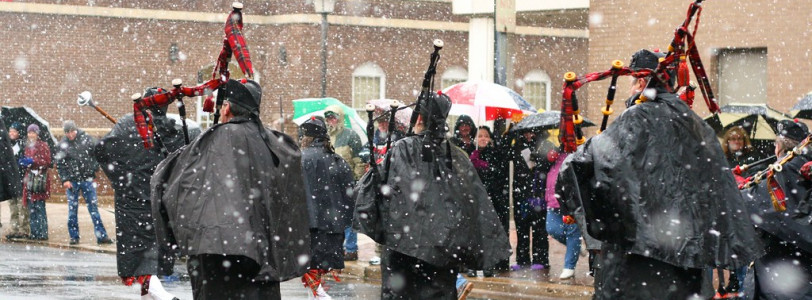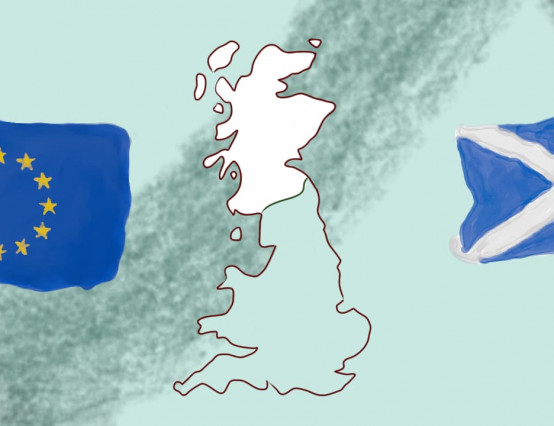History of Christmas in Scotland
In Scotland — before the reformation in 1560 — Christmas was recognised as a religious holiday, with feasts and festivities to mark it. However, in an effort to eradicate any ties to Roman Catholicism, the Scottish Parliament proclaimed any "Yule vacation" illegal, even requiring every baker to report anyone who asked for yule bread to the authorities. This law was introduced before Oliver Cromwell invaded Scotland, and was enforced long after Charles II was reinstated in England. Only during 1712 was the official ban revoked, but despite this, the Kirk (Church of Scotland) was still heavily against the celebration. In those days the word of the church was less a suggestion and more an uncompromising requirement. It took almost 400 years after it was banned for Christmas to become an entirely uncontroversial topic in Scottish society. In 1958, after years of Scots privately celebrating the holiday with quiet, unobtrusive markers, 25 December became an official public holiday — Boxing Day didn't follow suit until 1974.
It is thought by some that this contentious Christmas history is the reason Scots typically make a bigger deal of Hogmanay (New Year's Eve) than Christmas Day. As a result of this, much of Scotland's Christmas traditions stem either from before the sweeping ban, or directly from the US and the rest of Europe. However, there are still several festive traditions that are quintessentially Scottish.
Christmas traditions
The burning of a rowen stick
Exactly what you'd expect, take a twig from a craobh caorann (rowan tree) and chuck it on the fire. Burning it wards off negative feelings from cantankerous spirits, and sweeps away old grudges between friends, family, and neighbours.
Relics of a forgotten age
Yule bread with hidden trinkets inside, fortune telling using ash and egg-whites, the iconic use of mistletoe, all of them spring from Celtic traditions and Viking influence. Whilst mistletoe, which saw its origin in Druidic Celtic rituals and Norse mythology, is the only one to have reached global fame, many ancient traditions influence the way Christmas is celebrated today.
Scottish Krampus
A bit of a niche one, the concept of a Scottish Krampus (essentially the anti-Santa) rears its head on the Hebridean island of Islay. Used by parents to frighten their children into behaving well, the story goes that the Crom Dubh na Nollaig (the dark crooked one of Christmas, which is the most metal name ever) pays a visit to children that act up during the festive season, and that the howls of the wind coming down the chimney acts as a harbinger of its arrival, as the sounds reflect its baleful howl. Cheery stuff.
Festive Food
There's a selection of Scottish dishes that will often grace the dinner table on 25 December. Cock-a-leekie soup is a common starter. It's a delicious broth mixed with chicken, leeks and other vegetables. Prunes and an assortment of other meats can be added at the maker's discretion. Haggis bon-bons make for an excellent side dish. Clootie dumplings are lovely, stodgy puddings that require a hefty amount of preparation. Finally, for a bit of pep in your step you can have a tipsy laird, which is essentially a trifle with a dash of whisky.
Hogmanay traditions
First footing
An important Hogmanay tradition said to bring good luck for the rest of the year, 'first footing' is when you're the first visitor to pass a home's threshold during the new year. You must not have been at the party beforehand, and should always come bearing gifts of whisky or traditional treats. Historically it tends to be a dark-haired visitor that's said to bring luck (given that a fair-haired visitor could be a rampaging Viking) although this isn't strictly adhered to.
Auld Lang Syne
'Auld Lang Syne' is a song that sprang from the renowned poet Robert Burns. Its title means 'long times past', and is sung in unison on Hogmanay right after the bells to celebrate another year gone by. Folk join hands to sing the iconic lyrics, and by the final verse, cross arms and storm inwards and back out again (although this is usually reserved for ceilidhs). Interestingly enough, the song was originally written with an entirely different melody in mind, and was sung with a more melancholy feel, with Burns addressing his brother, with whom he'd lost contact.
Edinburgh Street Party
Okay, okay, this isn't exactly an age-old tradition, but it's one that's dear to many Scot's hearts (unless they happen to live in Edinburgh). The only festival to feature on the Discovery Channel's 'Top 25 World Travel Experiences', it sees the entirety of Princes Street and its surrounding area blocked off and turned into one massive venue. It's a hugely popular event, with over 75,000 revellers joining the party in 2020. Heaps of live music, food and drink stalls, and fireworks displays, all make this one of the best ways to usher in the new year.
The Loony Dook
Begun in 1987 by a few locals of South Queensferry looking for a hangover cure, The Loony Dook refers to taking an early morning dip in the Firth of Forth on New Year's Day, sometimes whilst in fancy dress. There's been a sharp increase in participants in the last decade, leading to more safety measures and added flair, although if you ask me, whoever decided to turn it into a pricey ticketed event ought to get a 'first foot' right up the bahoochie.
And that's it! Share your festive traditions @voicemag.uk, and if we missed any of your favourites, let us know!
Nollaig Chridheil!









0 Comments